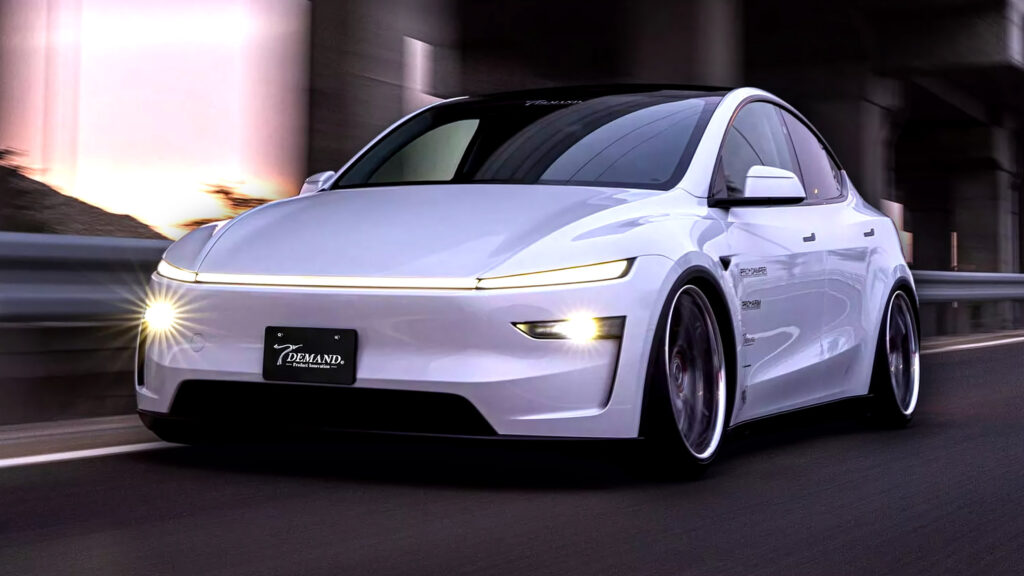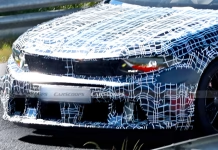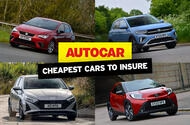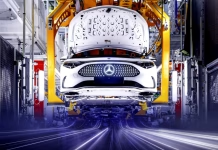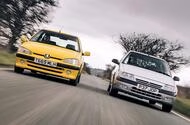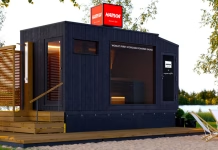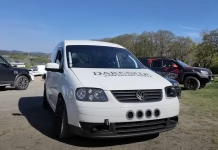Revving Up: The Next-Gen BMW M5 Unveils a Striking Facelift and Performance Upgrades
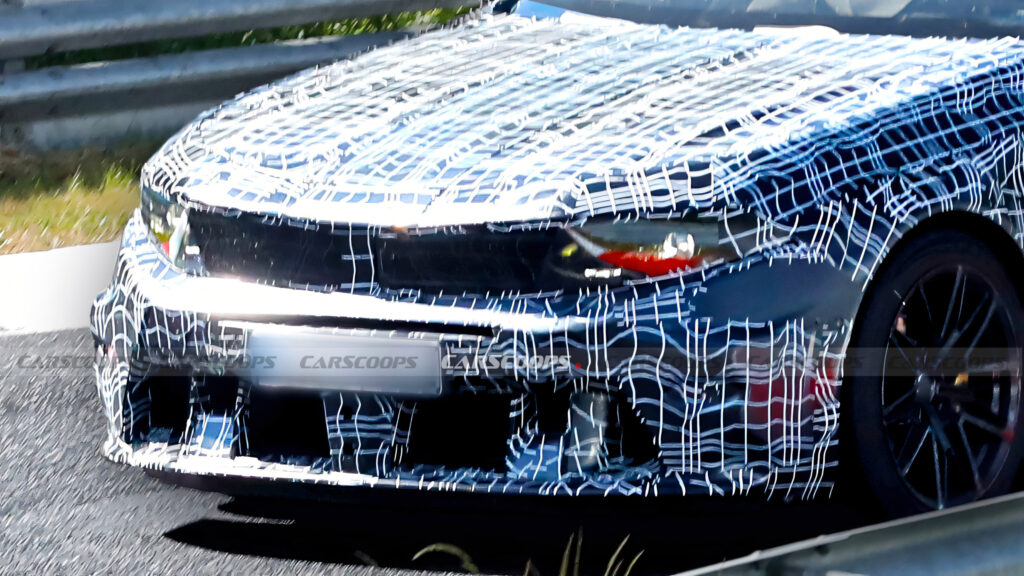
Affordable Wheels: Discover the Cheapest New Cars to Insure in the UK
 Car insurance can hit your wallet hard, but there are a few models out there with surprisingly low premiums
Car insurance can hit your wallet hard, but there are a few models out there with surprisingly low premiums
Car insurance is up there with the worst drivers of the cost of living crisis, and finding the cheapest new cars to insure is a must-do, particularly for new drivers.
According to data from comparison site Confused.com, the average premium increased by £284 in 2024, up year on year by 43% to a whopping £941.
But don’t fret. It appears there’s good news on the horizon. Prices have gradually dropped over the past few months, and the average quote is now around £834.
That’s not exactly cheap, of course, but there is still a good choice of affordable cars in low insurance groups that can help to bring the cost down even further.
This top 10 list features affordable cars ranked in order of the cheapest available car insurance quotes. Each quote is based on a 35-year-old male who lives in Swindon and works as a teacher.
This driver commutes by car, parking it on the street during the day and in a residential space overnight. He drives 8000 miles per year. His licence has no penalty points and a full 18 years of no-claims bonus.
According to our research, the cheapest new car to insure in the UK today is the Toyota Aygo X. Read on to see the rest of the top 10, which consists mostly of superminis and hatchbacks, with the odd SUV here or there…
Epic Motorcycle Journey Unveiled: The BDR Team’s Adventure Documentary is Here
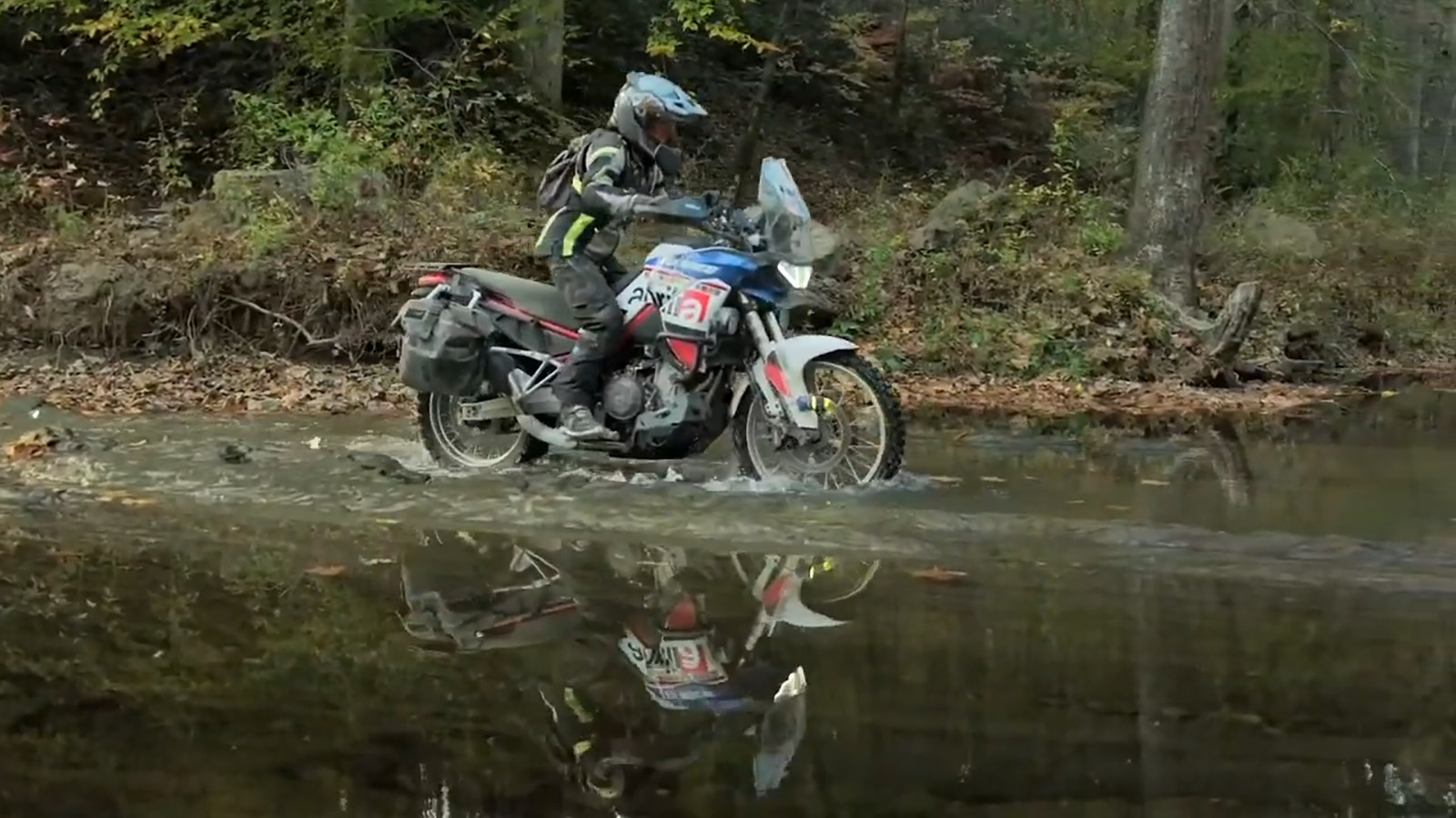
Rare Earth Crisis: How China’s Export Restrictions Are Halting Auto Production
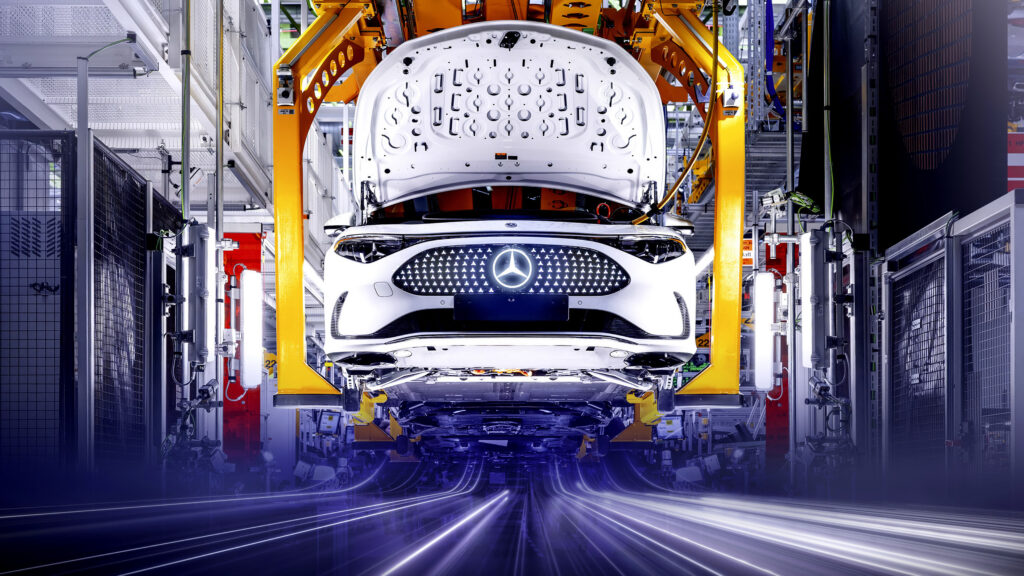
French Hot Hatch Showdown: Peugeot 106 GTi vs. Citroën Saxo VTS – A 90s...
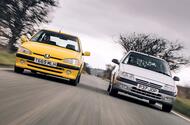
Peugeot’s and Citroën’s pared-back takes on the hot hatch theme still hit the spot todayIn the 1990s, soaring insurance costs put paid to affordable hot hatch fun – until this duo arrived
The 1990s wasn’t the friendliest environment for hot hatchbacks. The previous decade had bred some of the genre’s biggest icons, but an epidemic of thefts and spiralling insurance costs began to stifle car makers’ swagger.
The Golf GTI, a pioneer of the formula, was softened in its third generation, while the Escort Cosworth’s irresistibility to more than its paying customers meant Ford’s follow-ups lost their lustre too.
Thankfully, towards the decade’s close, rescue came from a reliable source of inexpensive fun: the French. The cars you see here were not only dinky in size and affordable, but their running costs were also attainable by everyday folk.
The Citroën Saxo VTS was flung to the top of the hot hatch sales charts by its now ludicrous-sounding free insurance deals, which, allied to its slim list price, lured in a younger demographic than that of the new car norm.
The Peugeot 106 GTi was a bit less bargain-bucket in its approach, but it is rumoured to have lowered its premiums another way. While the pair share the same genes, right down to identical four-cylinder engines, there was a minor gulf in their performance figures – chiefly the 106 taking half a second longer to hit 60mph than its non-identical twin.
The internet is awash with speculation about why that was the case, but the pair claim identical gear ratios, quelling any suggestions the Saxo could hit the accelerative benchmark with just one gearchange.
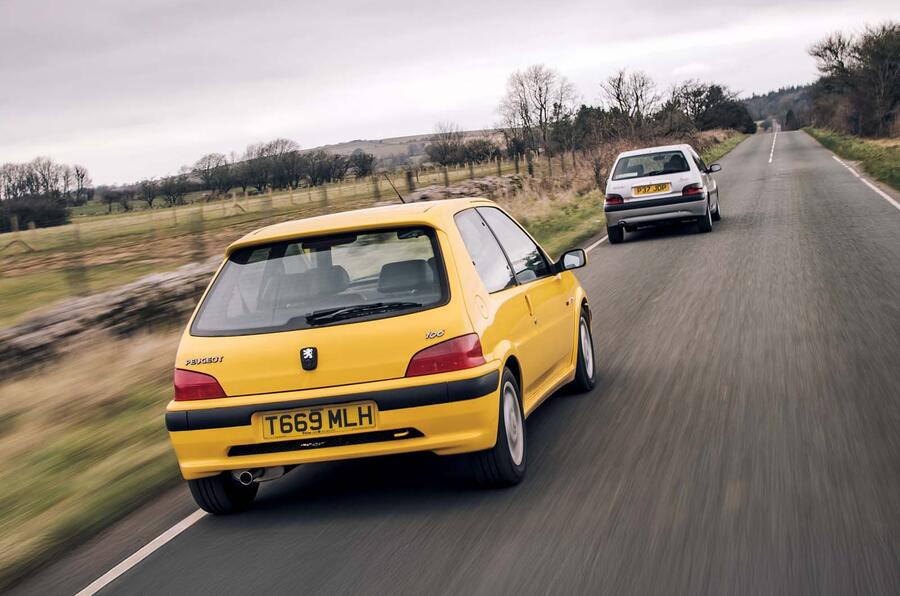
That only throws more weight behind the old wives’ theory that Peugeot started the stopwatch with more ballast on board in order to sandbag its car into a lower insurance group.
Either way, these are both joyously simple devices at their core. Each deploys a 120bhp 1.6-litre 16-valve naturally aspirated four-cylinder engine that is allied to a short-stacked five-speed manual gearbox and powering the front wheels bereft of complicated electronics or intelligent differential set-ups to interrupt the process. Their suspension set-ups are a mix of off-the-shelf struts, trailing arms and a torsion bar.
Their exterior designs don’t feel too far from the regular parts locker, either: there are no wider tracks or requisite swelled arches, no muscular bonnet humps or indeed much you would describe as ‘bodykit’.
Their 14in alloys look delightfully restrained now but surely acted as placeholders for 1990s buyers itching to redeem their Demon Tweeks gift card. It’s small wonder cars such as these were quickly modified to the hilt, no doubt tearing those noble insurability claims into tatters.
That does, however, make it ever trickier to hunt down examples that haven’t been tuned, crashed or eaten by corrosion. The pair we have here must be among Britain’s very best remaining examples of each, and they both represent the apples of their respective owner’s eye.
The 1999 106 GTi has joined us from South Wales, where Carl Lampard has kept it for seven years, fully repainting it in its dazzling Sundance Yellow during a restoration to borderline brand- new condition. Everything, down to its official 106 GTi mats, looks as standard as the day it was born.
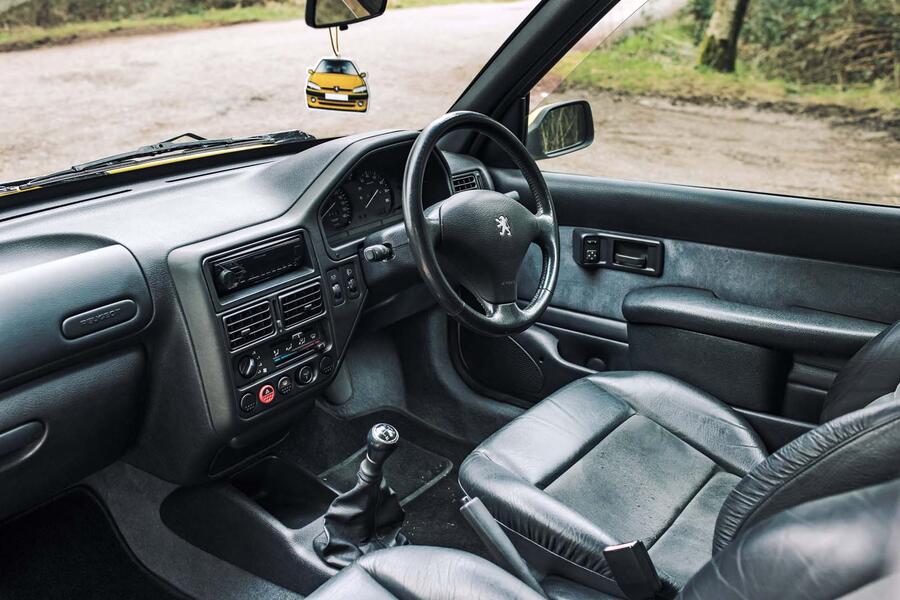
The 1997 Saxo VTS driven up from the south coast by Zac Jiggins is more demure still, a very early Quartz Silver car lacking even a rear spoiler to hint at any aggression beneath.
He has owned his Citroën for five years, and it arrives in front of photographer Jack’s camera fresh from an engine rebuild to ensure it feels as factory-fit as it looks. Both Carl and Zac appear too young to have lusted after these cars new but, crucially, they’re pouring their time and money into faithfully maintaining their original condition now. A true antithesis to the clientele who could have got their modifying mitts on these cars new.
Two special cars, then, ensuring today isn’t about cutting the same outlandish shapes as Tiff Needell on Autocar’s £15,000 performance mega-test around Rockingham in 2003, when these cars laid waste to some huge names to finish fourth and fifth out of 25 cars. Yep, 25 sub-£15k cars. You can barely get a base-spec Dacia for £15k now.
While the Saxo nipped ahead of the 106 on that occasion, the pair exchanged places in our affections across their six years on sale to hammer home with conviction just how closely related they are beneath their skin.
Yet flick through any period magazine and you will discover they offered quite different driving experiences: the Citroën is more agile, exciting and occasionally wayward, while the Peugeot operates with a mite more professionalism to serve up even greater thrills (at least on the road) with its greater breadth of ability in all conditions.
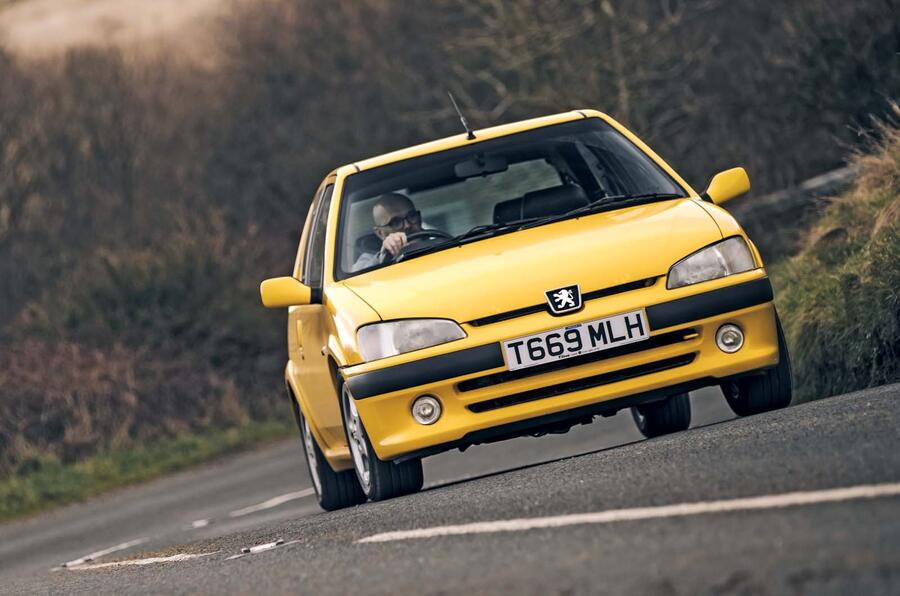
What united them both were lap times that outgunned more muscular competition: their flyweight physiques, keenly revving engines and hyperactive handling propelled them around racetracks with the startled energy of a fly stuck in a hot room.
Once again, the truth behind their handing differences is argued at length online, but the debate appears to focus on the 106 getting grippier tyres from the factory – and there are plenty of forum anecdotes of both cars exhibiting frenzied (or downright frightening) lift-off oversteer during ownership. Today, we have a grubby British morning to ride their waves of excitement and see how they each stack up almost 30 years after their respective launches.
What they both share is an upright driving position and a cramped, offset pedal box. That you can still heel and toe with such a tiny throttle is a credit to the sharpness and accuracy of the controls beneath your feet. They possess similar steering wheels too, each perfectly proportioned and sited ahead of an attractive set of Jaeger dials with alternative colour schemes.
Cute immobiliser keypad aside, the Saxo cuts a more modern dashboard aesthetic, while the 106 visibly shares vents and controls with Peugeots from a decade before to betray the fact that GTi trim arrived with the 106’s mid-life facelift, while the Saxo was fresh on the market.
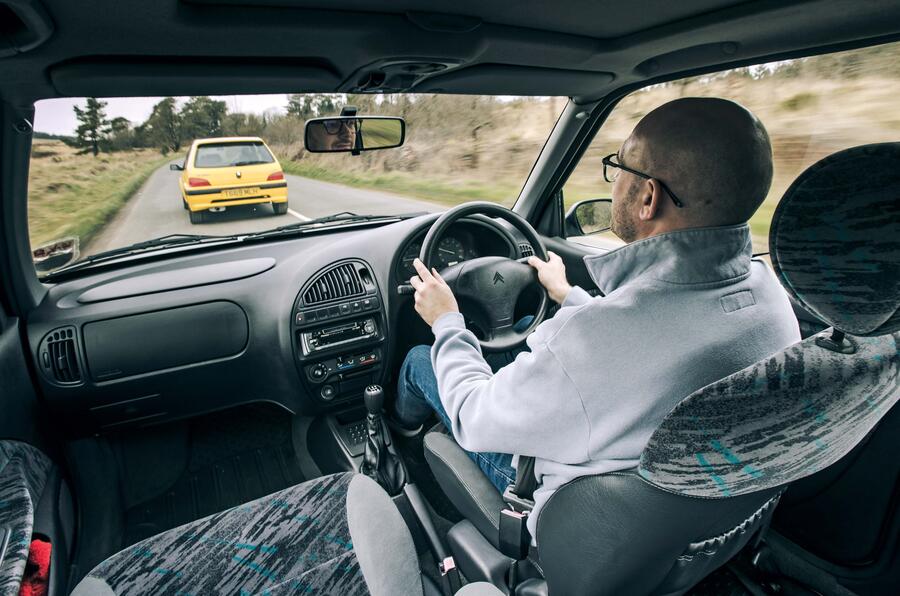
I begin in the Peugeot, its hardened four-cylinder soundtrack and vibrant paint ensuring it buzzes down the road like an angry little hornet. Its steering is quick, alert and full of feel, while its modest 107lb ft of torque vastly over-delivers with less than a tonne to propel.
The gearshift is a little notchy and a far cry from the slicker shifts we’ve enjoyed in more modern and sophisticated hatches since, but the GTi is already a delightful palate cleanser that still feels quick enough to be relevant.
True to form, the Saxo is immediately more agile. It points so incisively into corners that you’re almost caught off guard, while the rear wheels lighten with just a hint of a relaxed throttle.
With more aggression, you can sense its bum poised to pivot round at the point the 106 is still working its grip more evenly across all four wheels. This is in mostly dry conditions, but were there more rain, I sense a perkier, perhaps meaner streak, is lurking within the VTS.
Yet it’s probably more addictive as a result, a live wire in which it is hard to resist upping your game while at the wheel. It charges hard even with a polite 5000rpm cap to avoid punishing Zac’s refreshed engine, and it eagerly matches the Peugeot’s enthusiasm.
The Citroën has the smoother, neater gearshift of the pair and feels the more refined and finessed car to operate, despite the potential mischief barely concealed beneath.
Both of them proudly demonstrate the endless benefits of making a car small, light and agile, and while they probably wouldn’t impress the Euro NCAP testers now, each has airbags, ABS and luxuries such as electric windows and power steering to prove they were always value propositions rather than outright cheap.
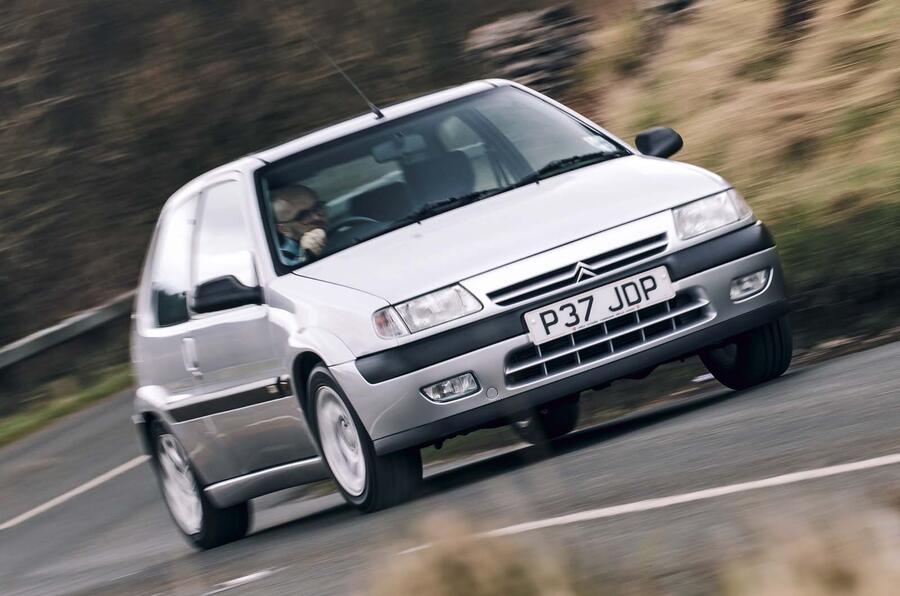
Each rides well on its 185/55 tyres and is narrow and nimble enough to snick around potholes anyway, negotiating the worst of broken British B-roads in its own inimitable way.
On quicker asphalt they will both buzz away above 3000rpm during a 70mph cruise, and you’d need a strong resolve to daily one now – not least because you’d be exposing an appreciating asset to the grit and grime of a British winter.
The Saxo VTS is the flamboyant extrovert, a car that’s truly got under my skin on these tight Somerset lanes, while the 106 GTi is the more precise and accurate device, though still emboldened with a sense of humour.
It feels like it would make a superior circuit toy, allowing you to bombilate around your local track evening without spending a fortune on fuel and tyres – not to mention doing so while embarrassing quicker and pricier cars in the process, just like this pair of French fancies did in those turn-of-the-century track tests.
Ultimately these saviours of the affordable hot hatch remain enticing for more than simply their valour. I’ll take one of each.
Toyota’s Innovative Hydrogen Sauna: A Step Towards Carbon Neutrality
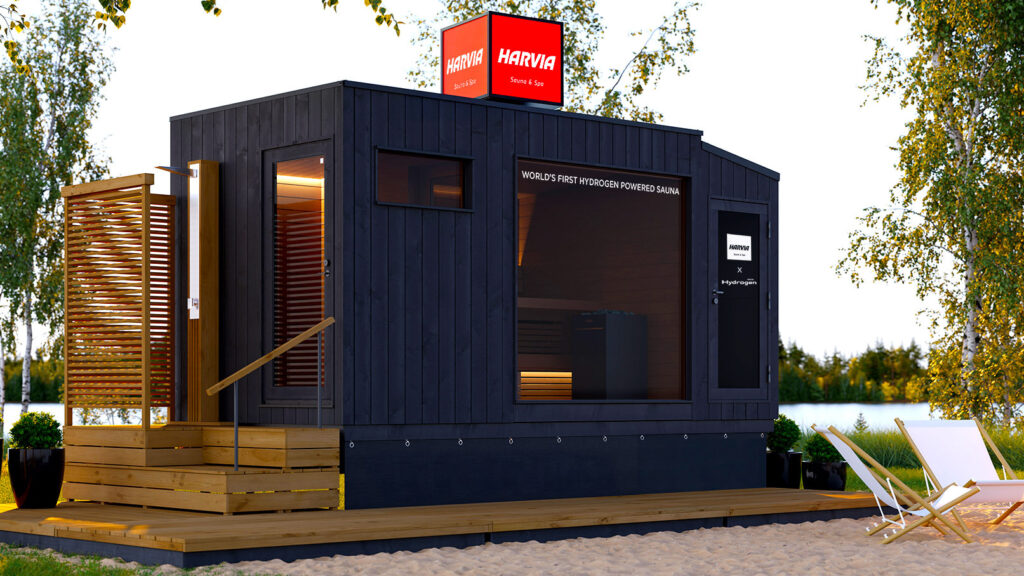
New Diesel Champion: Volkswagen Caddy Shatters Van Lap Record at Nürburgring

Vandalized Luxury: The Mercedes GLS with a Heartbreaking Story Up for Auction

Navigating Space’s Peril: NASA’s Unwanted Reliance on Russia

Transforming Tesla: The Bold Lowrider Makeover of Model 3 and Y
